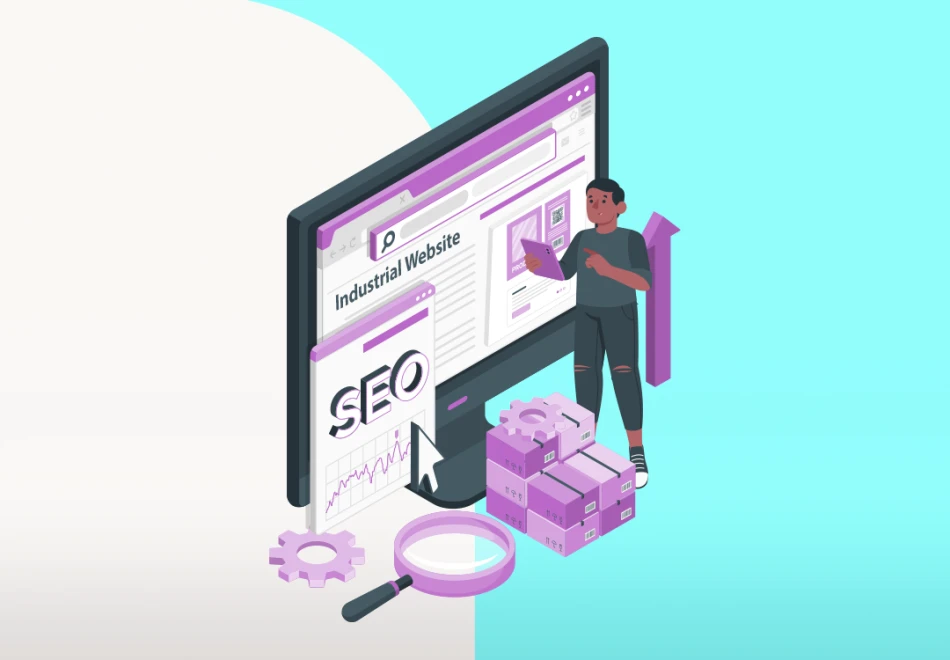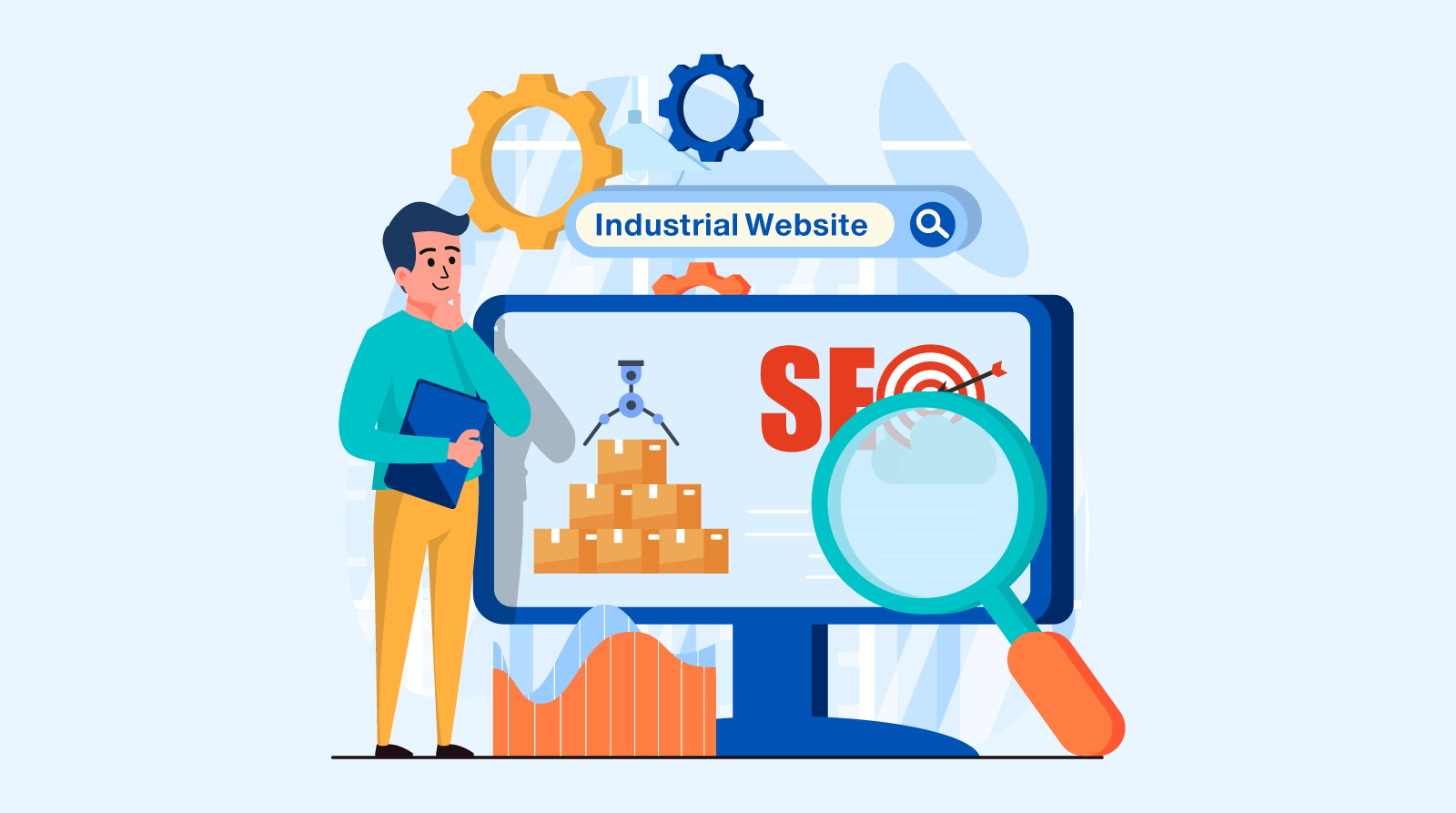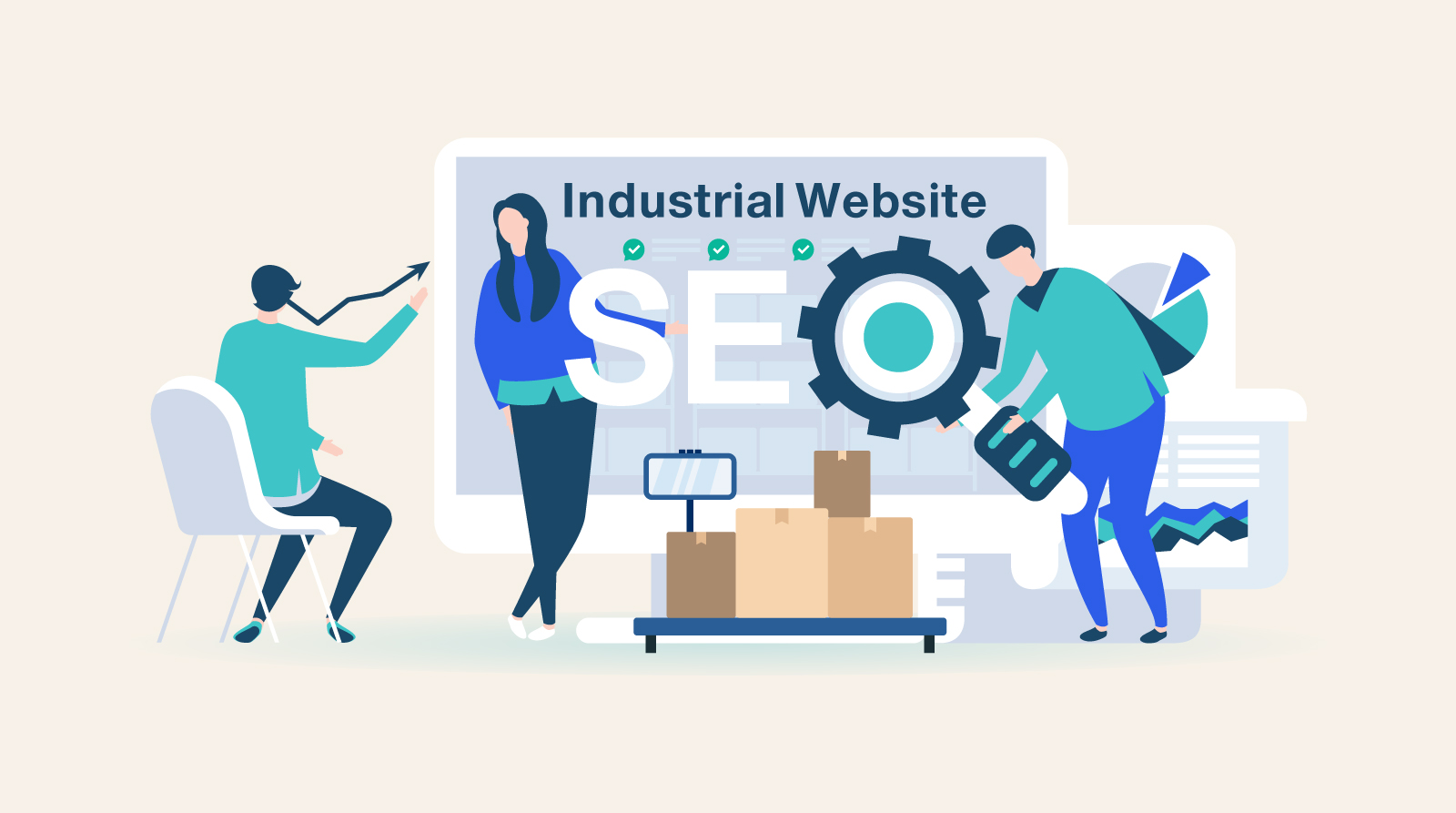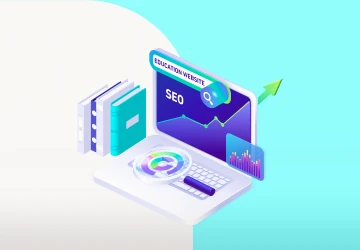SEO for Industrial Websites: Unlock B2B Growth

In 2025, the digital world for industrial websites is tougher than ever.
If you're not prioritizing SEO for industrial websites, you're already falling behind.
With manufacturing SEO on the rise and algorithms constantly changing, staying ahead is key to keeping your business thriving online.
That's why I've put together the best strategies, tips, and insights you need to win.
In this guide, you'll discover simple, actionable tactics—from fine-tuning your keywords to making technical upgrades—that boost your online visibility, attract quality leads, and set your industrial website on a steady path to success.
What Is Industrial SEO?
Simply put, industrial SEO is about helping industrial companies rank higher in search engines like Google and Bing.
When someone searches for products or services that a manufacturer or distributor offers, you want your website to pop up—that's where SEO comes in.
It works by making your site more attractive to search engines.
This usually means writing useful content, using the right keywords, and getting mentions (or "citations") from other trusted sites.
There are a few different parts to industrial SEO, and they all work together:
On-page SEO: This is everything you do on your website, like writing helpful articles or optimizing product pages.
Off-page SEO: This happens off your site, like getting other websites to link to you or mention your business.
Technical SEO: This focuses on how well your website runs behind the scenes, like how fast it loads or how easy it is for Google to read it.
Local SEO: This helps people find you locally by making sure your business info is correct on maps and directories.
The best industrial SEO strategies use a mix of all these types because search engines look at hundreds of signals when deciding who ranks where.
And industrial SEO isn’t just for one kind of business—it can help all sorts of companies, like:
Manufacturing plants
Warehouses
Distribution centers
Custom, made-to-order (MTO) facilities

Why Does Industrial SEO Matter?
People want to find answers fast, and they turn to search engines like Google and Bing to find answers.
Whether they’re buyers at a manufacturing company or individuals searching for specific industrial solutions, they use search to guide their decisions.
If your business doesn’t show up in those results, you’re pretty much invisible to them.
That’s why industrial SEO matters so much—it helps you get found by the right people at the right time.
Here’s what it can do for your business:
Stay competitive: Even though SEO might feel more "tech" than "industrial," tons of industrial companies are already using it to get ahead. If you’re not optimizing your site, chances are your competitors are—and they’re getting the leads you’re missing.
Climb the Rankings: The better your SEO, the higher you show up in search results. And being near the top means more clicks, more traffic, and more opportunities to turn those visits into sales.
Make Customers Happy: Good SEO isn’t just about keywords—it’s also about creating a smooth experience. When your site is fast, helpful, and easy to use, visitors are more likely to trust you and convert.
Reach Buyers at Every Stage: Whether someone’s just starting to explore options or ready to buy, industrial SEO helps you show up with content that answers their questions and builds confidence.
Get Better Leads, for Less: Like paid ads, SEO lets you target specific search terms. But the difference? You don’t pay for every click. That means you can attract more qualified leads without the high cost of PPC.
Shorten the Sales Cycle: With the right content in place, potential customers can get the info they need upfront, so by the time they contact you, they’re ready to move forward.
Build a Strong Reputation: Showing up consistently in search results helps position your business as a trusted leader in your industry.
Now, SEO isn’t the only game in town—PPC (pay-per-click ads) also has its perks, like immediate visibility and advanced targeting.
But if you’re choosing where to start, SEO is often the better long-term investment. It keeps working for you without the constant cost of ads.
How to Build an Effective Industrial SEO Strategy?
1. Align SEO with Sales and Marketing Goals
Forget starting with keywords—start with conversations.
Before diving into SEO tools or spying on your competitors’ rankings, ask yourself: What do we want to be known for?
Because in the world of industrial SEO, you’re not just chasing clicks—you’re building authority, trust, and ultimately, sales.
Imagine your ideal prospect is sitting across the table:
What are they asking?
What are they worried about?
What part of your pitch makes them nod and say, “That’s exactly what we need”?
That’s where your SEO journey begins.
Instead of obsessing over keyword gaps, start by syncing with your sales and marketing teams.
They’re already having these conversations daily.
Tap into their knowledge:
What questions come up over and over?
What objections are hardest to overcome?
What kind of information makes prospects feel confident enough to say “yes”?
Your job is to bring those conversations online—turn them into helpful, optimized content that works even when your sales team is asleep.
Once you’ve nailed the real-world messaging:
Use SEO tools to find how people phrase those questions in search engines.
Google those phrases. See who’s already ranking.
Then? Plan how to beat them. Be clearer, go deeper, be more helpful. Make it impossible for searchers to click away without learning something valuable.
This isn’t about playing catch-up with competitors—it’s about leading the conversation in your industry.
And when your SEO is aligned with what your sales team is already saying, it becomes a powerful engine for trust, traffic, and conversions.
2. Choose Specific, Technical Keywords (B2B Focus)
SEO for industrial websites needs to go beyond basic keyword volume.
In the B2B world, you're not trying to rank for what everyone is searching for—you’re aiming to rank for what your ideal buyer is typing into Google at 10 a.m. with a coffee in hand and a purchase decision on the line.
Let’s take an example.
Say you’re in manufacturing SEO, and you sell air filtration systems for industrial use.
A tool like SEMrush might suggest “air filtration” as a top keyword. It looks good, right? Tons of volume.
But if you Google it?
You’ll mostly see residential air purifiers.
Not exactly what Engineer Joe, who’s managing a production facility, is looking for.
Now, imagine Joe tries again with something more specific—maybe “custom air filters” or “industrial custom air filtration systems.”
This time, he lands on results that speak his language.
That’s the sweet spot.
Online visibility isn’t about showing up in every search—it’s about showing up in the right ones.
That’s why for SEO industrial websites, the real magic happens when you:
Think like your customers (especially when they don’t know your brand yet).
Prioritize specific, technical phrases they’d realistically search.
Avoid casting a wide net with generic terms like “web design” or “graphic design” that lead to irrelevant clicks.
Instead of just relying on keyword tools, trust your instincts:
What would your best customer type into Google if they didn’t know your company name?
Which of your product or service terms are widely recognized in your niche?
What jargon do your customers already use?
Pro tip: Search those terms yourself. Look at the results. If they don’t align with your B2B offer, dig deeper until you find the keywords that do.
3. Target Long-Tail Keywords
SEO industrial websites thrive when they tap into long-tail keywords—the quiet underdogs of the search world.
These are the longer, more specific phrases people type when they know what they want, like “custom stainless steel pipe fittings for food processing.”
Unlike broad terms with high competition and vague intent, long-tail keywords are laser-focused.
That’s what makes them perfect for manufacturing SEO strategies.
Why do they work so well?
Simple:
They’re easier to rank for.
They attract searchers who are further down the buying funnel.
They speak directly to your ideal prospects, especially if you offer niche or specialized products.
Think about it: Someone searching “valves” might be a student or just curious.
But someone Googling “food-grade butterfly valves for dairy plants”?
That person is ready to talk business.
To find these golden phrases, start with what matters most to your business—your core products or services.
Use a free keyword research tool and plug in those terms.
Look at the longer, more detailed queries that pop up.
That’s your roadmap.
And here’s the best part: using long-tail keywords not only improves your online visibility, it also boosts the quality of your leads.
You’re not just getting clicks—you’re getting clicks from the right people.
4. Build Out Product and Service Pages
SEO industrial websites aren’t complete without strong product and service pages—they’re your digital sales reps, working 24/7.
Think of it this way: when someone’s Googling a specific solution, they’re looking for details.
Dimensions, materials, certifications, order minimums—real info that helps them decide what to do next.
By building out these pages with that level of detail, you're giving your potential customers exactly what they came for.
Plus, there’s a hidden benefit: manufacturing SEO isn’t just about bringing in more leads—it’s about bringing in the right ones.
A well-optimized product or service page helps weed out unqualified visitors.
That means your sales team can spend less time answering “do you ship overseas?” and more time closing deals.
Getting started?
Start by spying on your competitors.
Look at how they structure their product pages.
What kind of images or specs do they show? What’s missing?
Then, team up with your designer and developer to bring your page to life—both visually and technically. And don’t skimp on the content.
Aim for at least 500–800 words that clearly explain what you offer, who it’s for, and why it matters.
Use your target keywords naturally, and don’t forget to bake in online visibility by making your content helpful, clear, and crawlable.
5. Create Unique, Helpful Content
SEO industrial websites aren’t built on fluff.
They thrive on substance—on content that answers real questions, solves real problems, and speaks the language of your audience.
We’ve all seen those hollow articles stuffed with keywords and filler.
They rank for a second, maybe.
But do they build trust? Do they lead to conversions?
Not a chance.
In the world of manufacturing SEO, your content is your conversation.
So instead of writing for search engines first, write for the people who are searching.
Say you’re talking to an engineer or operations manager who's hit your page because they’ve got a problem to solve.
What do they need to hear? What do they want to learn? What will make them think, “These people get it”?
Start with relevance—real, specific relevance to a defined audience.
Then make it substantial. Don’t skim the surface. Dive deep.
Show your experience, your expertise, your authority.
Make it so useful and clear that even if a prospect doesn’t convert right away, they remember your name when they’re ready.
Structure is key too. Break up long paragraphs.
Use headings, bullet points, visuals—whatever makes it easier to absorb.
Just because your audience is technical doesn’t mean they want a wall of dense text.
Even Google’s algorithm favors readability and clarity.
Length?
Go as long as it takes to thoroughly answer the question.
Whether it's 1,000 or 2,000+ words, the goal is to give a complete, satisfying answer.
Because that’s what Google—and more importantly, your prospects—are looking for.
And remember: originality matters.
Every piece of content should be fresh, unique to your site, and full of your brand’s perspective.
Recycled content might seem like a shortcut, but it won’t help your rankings—or your reputation.
So, how do you start?
Talk to your sales and support teams.
They know what questions are being asked.
Use keyword tools and industry forums to find themes.
Then work with a copywriter or your internal experts to translate that insight into content that builds trust and boosts online visibility.
6. Optimize for Local Search
SEO industrial websites aren’t just built to get attention from people across the country—they can also help you show up for the folks right down the street.
Think about it.
Even in B2B and manufacturing, people still search locally.
A plant manager might be looking for a nearby parts supplier.
An engineer might need a trusted vendor just a few miles away.
If your business shows up when they search, that’s a win for your online visibility—and a big step toward earning new leads.
That’s where local listings come in.
Platforms like Google Business Profile or Bing Places act like your business card, storefront, and pitch—rolled into one quick profile.
When set up right, they don’t just show your location on a map.
They show your contact info, photos, services, and reviews—basically, they tell people “Hey, we’re legit, and here’s why.”
And here’s the cool part: Even if you don’t just serve one area, having a clean, professional local profile still helps.
It gives buyers a quick feel for your company—who you are, what you do, and why they should trust you.
Getting started is pretty simple:
Claim Your Listing on Google or Bing.
Add the Basics: Name, address, phone, and website.
Upload Some Photos: Your workspace, your team, your products.
List Your Services: Let people know exactly what you offer.
Ask for Reviews: A few good ones can go a long way.
7. Ensure a Responsive Website
Ever tried visiting a website on your phone and had to pinch, zoom, and scroll like crazy just to read anything?
Yeah—not fun.
That’s what happens when a site isn’t responsive.
A responsive website simply means it works well no matter what device someone is using—whether it’s a desktop, laptop, tablet, or smartphone.
The layout adjusts automatically, so it looks good and functions properly across the board.
Most modern site builders already include this feature, but it’s still worth double-checking.
Why does this matter for industrial SEO?
Because search engines, especially Google, crawl and rank websites as if they’re using a phone.
If your site isn’t mobile-friendly, Google’s likely to push it down in search results—and you’ll probably lose potential leads who bounce off out of frustration.
Want to see how your site stacks up?
Open up a free tool like Chrome DevTools or Blisk to preview how your site looks on different screen sizes.
Or just grab your phone and check it out.
If anything looks off—text too small, images misaligned, buttons too hard to tap—it’s time to call in a developer to make things right.
8. Prioritize Technical SEO
You’ve probably heard that “content is king” when it comes to SEO—and that’s true.
But even the best content in the world won’t get you far if your website has technical issues behind the scenes.
Think of it like this: Content is the message, but technical SEO is the microphone. If the mic’s broken, nobody hears you.
So, what are we talking about when we say “technical SEO”?
It’s all the stuff that makes your site function smoothly and helps search engines find and understand your content.
That includes things like:
Making sure your site is mobile-friendly
Ensuring it loads quickly
Fixing 404 errors (aka dead links)
Making your site easy for Google to crawl
Delivering a solid user experience overall
If your site struggles with any of these, even your most polished, keyword-optimized content might go unnoticed.
Getting started doesn’t have to be complicated.
Run your site through free tools like Google Search Console, PageSpeed Insights, or even Screaming Frog SEO Spider if you’re feeling fancy.
These can help you spot red flags, from slow loading times to broken pages.
Once you’ve got your list, work with a developer—or your in-house team—to clean things up. It’s not the flashiest part of SEO, but it’s foundational.
Because if Google can’t crawl your site or users leave after two seconds of lag… well, you’re not just losing traffic, you’re losing business.
How to Execute Your SEO Plan?
1. Edit Using Industrial SEO Best Practices
Behind every piece of content, there’s a whole system of elements that can make or break your SEO game.
These often-overlooked areas are your meta title, meta description, URL, and even your images.
Each of these components plays a crucial role in how search engines view and rank your site, as well as how visitors perceive it when they see your page in search results.
Start with the meta title, which is like the headline on a product brochure.
This is the first thing users see, so it needs to be clear, concise, and compelling.
The meta title should naturally include your primary keyword, ensuring that it not only grabs attention but also accurately reflects the content of your page.
Keep it within around 60 characters to avoid it being cut off, and focus on crafting a title that feels both informative and enticing.
Next is the meta description—the mini sales pitch that appears under your title in search results.
This brief blurb needs to include your primary keyword along with any secondary keywords, giving readers a snapshot of what they can expect from your content.
With a character limit of about 160, it’s vital to be precise and direct.
Think of it as a teaser that nudges the right audience to click, promising them valuable information once they visit your page.
Your URL, or slug, might seem simple, but it’s another key piece of the SEO puzzle.
A clean, straightforward URL that includes your focus keywords helps both users and search engines quickly understand what your page is about.
A URL like “/industrial-seo-guide” not only looks neat but also reinforces your content’s purpose, making it easier to remember and share.
Don’t overlook your images either.
Every image on your page should be optimized by including a descriptive filename and an alt tag that integrates your target keyword or a close variation.
This not only improves your site’s accessibility but also contributes to your overall SEO by giving search engines additional context.
Adding captions to images can further enhance this effect, much like detailed labels that help explain every part of a complex product.
Beyond these technical details, your content itself needs a strong structure.
Begin by incorporating your primary keyword early in the introduction.
This immediately tells search engines and readers what to expect from your page.
Similarly, conclude with a section that reinforces your core message and includes a call-to-action, guiding your audience toward the next step.
It’s also important to consider how you organize your content with headings and subheadings.
Your H1 should prominently display your primary keyword and mirror the essence of your meta title, while the subheadings can naturally include secondary keywords.
This structured approach not only boosts readability but also makes it easier for search engines to understand the hierarchy and relevance of your content.
Maintaining a balanced keyword density is another key element.
Your primary keywords should appear naturally throughout your content—ideally about 1.5% to 3% of the overall text—while secondary keywords can be used more sparingly.
This balanced strategy ensures that your content remains engaging and informative without feeling forced or overly repetitive.
Furthermore, effective internal linking can boost your site’s SEO by connecting related content across your website.
Using descriptive anchor text that includes your primary keyword when linking to other pages helps search engines understand the context of your site, improving overall user navigation and engagement.
Similarly, outbound linking to authoritative sources adds credibility and reinforces your expertise in the industry.
2. Publish and Submit Content to Google
Once your content is live on your website, you might think the work is over, but this is when the real action begins.
Publishing great content is one thing, but getting it in front of the right people is where the magic of SEO for industrial websites happens.
First things first—use your marketing list.
If your content speaks to your target audience, send it out in an email.
A good trick here is to add an executive summary in the body of the email.
This lets readers get the main points without even having to click through, but be sure to include a link to the full article for those who want to dive deeper.
Next, make sure to spread the word on your social media platforms.
This is key for reaching more people.
Post about your new content, but don’t stop there—engage with it!
Like, comment, and share within your team or with important stakeholders to get the ball rolling.
The more interactions you get early on, the better chance your content has to reach a wider audience.
And while social media and email are great for getting your content out there, don’t forget the technical side.
Head over to Google Search Console and submit your new URL for crawling.
Google will eventually find it, but submitting it directly helps speed up the process.
Without this step, it could take weeks before your content is indexed.
By submitting the URL, you're telling Google, “Hey, this new page is here, take a look!”
This helps boost your manufacturing SEO and ensures your content gets ranked faster.
3. Continuously Monitor, Measure, & Improve
Once your content is live, the real work begins.
To make your SEO industrial websites strategy truly successful, you need to keep a close eye on how your content is performing.
It’s not just about putting it out there—it’s about understanding which pieces are attracting the most visitors, driving conversions, and sparking engagement.
Start by checking your content’s performance regularly.
Look at things like how many people are landing on your pages, how long they stick around, and if they’re converting into leads or customers.
Also, take note of the content that gets the most engagement—things like comments, shares, and clicks.
These are all signs that your content is hitting the mark with your audience.
Tracking this data helps you spot patterns.
You’ll quickly learn what’s working and what’s not.
This info is gold when it comes to refining your strategy.
If something’s not performing well, maybe it needs an update, more details, or a bit of SEO tweaking to make it stronger.
And don’t forget to apply what you’ve learned to future content.
Each piece is a chance to improve and make your next one even better.
How to Track Industrial SEO Results?
As we just explained, tracking the performance of your SEO industrial websites goes beyond simply checking off impressions and clicks.
It's about understanding the bigger picture: Is your SEO strategy driving meaningful business results?
To get a true sense of how well your content is performing, you’ll need to dig into a few key metrics that can unlock valuable insights.
Let’s start with the basics: impressions and clicks.
Impressions show how many times your content shows up in search results, while clicks reveal how many users are intrigued enough to engage with it.
But here’s the thing—while these numbers are nice, they don’t paint the full story.
You want to know if those clicks are turning into real opportunities.
That’s where engaged sessions come in.
This metric lets you see how long visitors are sticking around on your site and how much they’re interacting with your content.
It’s a good indicator of whether your content is capturing attention and offering value.
But let’s face it—what matters most to industrial companies is whether those visitors are turning into leads, requests, or sales.
Conversions, like quote requests or actual purchases, are where the magic happens.
Here’s the tricky part: tools like Google Analytics 4 can help you track these conversions, but they don’t always give you the full story.
They’ll show you how many people came from organic search and clicked on your content, but they don’t tell you what happens next.
For example, how many of those visitors were truly qualified leads? How many closed deals? And what was the average deal size?
To answer these burning questions, you need marketing automation software.
This is where the real power lies: by connecting your website’s analytics with your CRM system, you can track not only how much traffic you're getting but how that traffic is impacting your bottom line.
With the right platform, like RevenueCloudFX, you can bring together your SEO efforts and sales process, gaining a clearer view of your SEO success and how it’s driving business growth.
How Long Does It Take to See Results?
SEO industrial websites generally take about four to six months to show up.
That's because building online visibility and boosting your manufacturing SEO isn’t an overnight process—it requires careful, ongoing work.
Several factors can speed up or slow down this timeline.
For example, how strong is your website’s current SEO foundation?
If you're starting with a solid base, results might come in a bit quicker.
On the other hand, if your site needs a lot of changes or fresh content, it might take a little longer.
Also, the amount of time you invest in SEO optimizations plays a big role.
The more dedicated hours you set aside, the faster you might start to see improvements.
A great way to set expectations and create a more accurate timeline, especially when explaining your plan to leadership, is to run an SEO audit.
Tools like Screaming Frog offer free audits that give you a snapshot of where your site stands, or you can opt for a professional SEO audit service for a deeper dive.
This audit not only highlights areas for improvement but also helps forecast how long the SEO changes may take to make a noticeable impact.
What Does SEO for Industrial Websites Cost?
Although we can't pinpoint the exact cost for SEO for industrial websites without knowing your specific needs, there are some general price ranges to give you an idea.
On average, businesses spend anywhere between $2,500 to $10,000 a month on SEO services.
Local SEO tends to be on the lower end of the spectrum, while global or enterprise-level SEO comes with a bigger price tag.
The reason for this difference mainly comes down to the scope of work.
Tasks like improving your website's design, speeding up page load times, building organic links, and creating quality content all contribute to the cost.
It’s also worth noting that agencies usually offer a more comprehensive service, meaning they have a whole team of experts working on your project.
This can lead to faster and better results.
Freelancers, however, tend to charge a lot less, often up to 130% less than agencies.
While they can deliver great results too, they usually work alone, which means they might not be able to offer the same range of services or move as quickly as a full team.
Looking ahead, SEO pricing is also changing thanks to evolving search engine algorithms.
By 2025, Google will be giving even more importance to E-E-A-T (Experience, Expertise, Authoritativeness, and Trustworthiness) and author entities.
This shift means that businesses will need to adjust their strategies, which may impact SEO costs.
Even though SEO for industrial websites might seem like a big upfront investment, the long-term payoff is undeniable.
Compared to paid search, SEO often provides more consistent, cost-effective traffic.
Organic conversion rates are around 14%, while PPC ads only convert at about 10%.
FAQs
Which Industry Needs SEO Most?
Any industry aiming to increase online visibility and drive qualified traffic can benefit from SEO. However, highly competitive sectors like e-commerce, healthcare, and manufacturing often need it the most.
What Are the 4 Types of SEO?
The four main types of SEO are on-page SEO, off-page SEO, technical SEO, and local SEO. Each plays a key role in improving site rankings and visibility.
What Is Manufacturing SEO?
Manufacturing SEO focuses on optimizing a manufacturer’s website to improve its visibility in search engines. This includes targeting keywords related to products, services, and industry-specific needs.
How to SEO Your Company Website?
To SEO your company website, optimize on-page elements like titles, meta descriptions, and content. Also, improve technical aspects like site speed and mobile-friendliness, and build quality backlinks.
Final Thoughts
Finally, we've come to the end of this guide, and I hope you're now equipped with the knowledge to elevate your SEO industrial websites strategy.
Remember, SEO is a long-term game—consistency and adaptation to changes in algorithms are key.
A valuable piece of advice: continually monitor your results, optimize your content, and refine your approach to stay ahead of competitors.
If you need personalized help or want to dive deeper into optimizing your industrial website, feel free to reach out.







